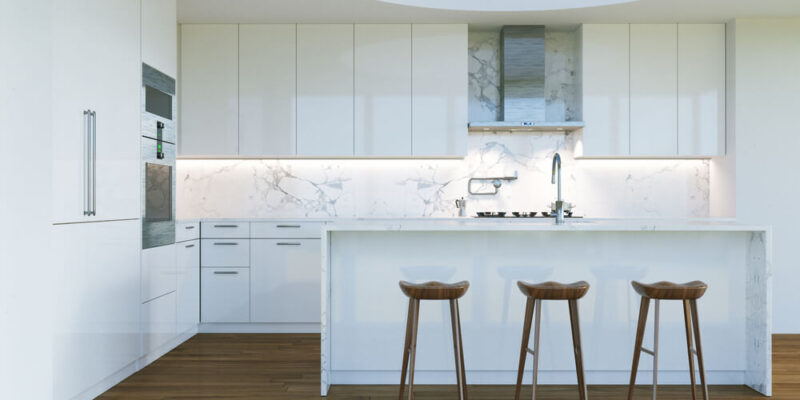Choosing paint for a kitchen is especially important because of the nature of the space and how it is used. In addition to choosing a pleasing color for this room in which you’ll spend a considerable amount of time, you also need to choose a paint that will hold up to use, and that is readily washable. The basic “scrub-ability” factor is determined by the paint’s sheen.
A kitchen is best painted with a semi-gloss or a high-gloss paint. To understand why you need to understand a bit about the different categories of paint and their differences.
What is Paint Sheen?
Paints for interior walls and woodwork come in several different finishes or sheens. The term “sheen” is used to refer to the level of shininess or glossiness that is evident in the coat of paint when it is dried. Each paint manufacturer has its terminology and means of categorizing the various sheen levels, but many manufacturers use a 5-level classification: flat (matte), eggshell, satin, semi-gloss, and gloss (or hi-gloss) to indicate the levels of shininess.
What Makes High-Gloss Paint So Shiny?
Technically, the sheen levels are identified by the amount of light they reflect, and this is determined by the paint’s chemistry. Shinier, high-gloss paints contain relatively high levels of resins and binders that create a shiny, smooth, hard finish that reflects a lot of light, while paints with a higher ratio of pigments will be flatter in sheen and more susceptible to wear. Because glossier paints contain less pigment and more binder, you may find it necessary to cover walls and woodwork with two or even three layers of paint to get complete coverage. This is a price well worth paying in a kitchen, though, where spills and splatters and other forms of heavy use will certainly mean that you’ll need to scrub the walls from time to time.
Differences Between Paint Sheens
Here is how paint manufacturers describe their different paint sheens and their recommendations for where to use each:
Flat or Matte: Provides a smooth, subtle finish that camouflages imperfections. Ideal for low-traffic areas. Flat paints diffuse light but tend to hold dirt and are more difficult to clean. Paint layer can be worn off with even minor scrubbing. Best suited for ceilings and walls in low-use rooms. Because it absorbs rather than reflects light, flat paints tend to hide wall imperfections.
Eggshell: This is a low-luster finish with similar merits to flat/matte paints. Eggshell paints are slightly more scrubbable than flat paints. Best suited for ceilings and walls in rooms that receive low to moderate wear.
Satin: This sheen provides a versatile, elegant finish that is perfect for more active rooms. It is an ideal multi-purpose paint for all walls in homes with children. It is a common choice for kitchen and bathroom walls.
Semi-gloss: This finish can be scrubbed clean easily, and has a finish that reflects light. It can be used for high-traffic walls, such as found in hallways, and for woodwork. Though more often used for woodwork, it is a viable choice for walls in high-use areas such as kitchens and bathrooms.
Gloss (High-Gloss): This is a very shiny finish that is ideal for rooms where frequent washing is likely. Not often used on walls, but is sometimes chosen for woodwork, since it survives frequent and heavy washing without any wear. Most people find it too shiny and industrial for use on walls. The extreme shininess can also expose flaws in walls.
What Sheen to Choose for Kitchens
Most people find that satin or semi-gloss paint works the best in kitchens. A common scheme is to use satin paint on walls, with semi-gloss paint used on any cabinets or woodwork that are also painted. Backsplash areas may benefit from semi-gloss or even high-gloss paint since they are likely to be scrubbed with some regularity.

